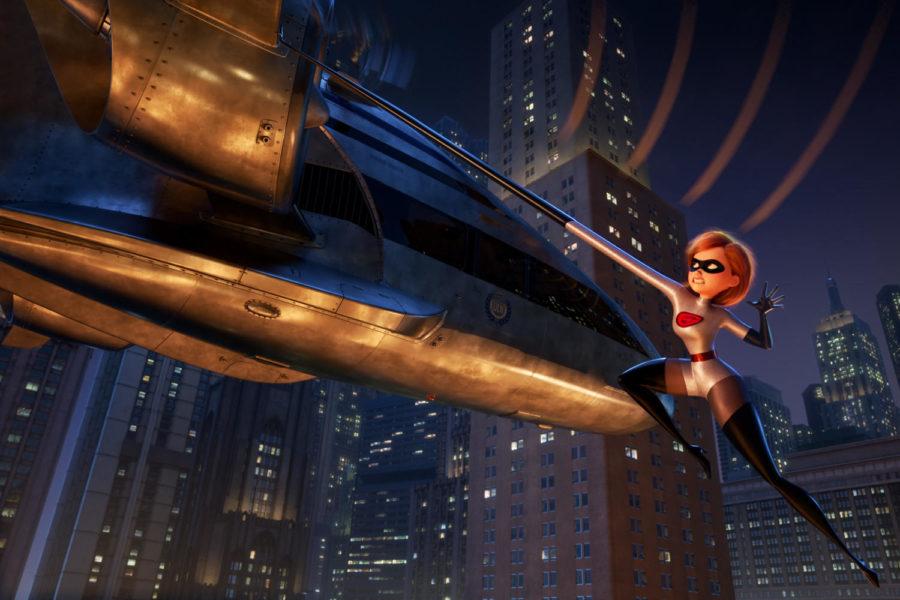After Disney-Pixar introduced international audiences to “The Incredibles” — a family of five superheroes struggling to live a super mundane life — the project’s creative linchpin, Brad Bird, kept busy. Blockbusters “Ratatouille” and “Tomorrowland” demanded most of his time, but the writer and director intermittently assembled pieces for the ’60s-inspired superhero sequel during the 14-year hiatus.
“Incredibles 2” picks up right where fans left the band of superheroes, but with improved 3-D computer animation that gives the retro-futuristic world and its characters a fresh look. At the end of the first movie, the family’s attempt to quietly reintegrate themselves into society is thwarted by the rise of the villainous Underminer, forcing the Incredibles to resume their role as crime fighters.
The family minimizes the Underminer’s destruction, with help from the ice-powered Frozone — played by Samuel L. Jackson — but their society at large pins blame on superheroes for their continued reckless interventions. Civilization’s previous generation of heroes were sent into hiding after costly lawsuits and negative publicity established grounds for outlawing the vigilantes.
Mr. Incredible, played by Craig Nelson, and Elastigirl, played by Holly Hunter, seem to have no choice but to once again assimilate the family to avoid prosecution — but the founders of global telecommunication company DevTech propose an alternate course of action.
The company aims to document the superheroes’ heroics and launch a carefully constructed public relations campaign in hopes of flipping society’s negative perception of superheroes. Company founders and siblings Evelyn, played by Catherine Keener, and Winston Deaver, played by Bob Odenkirk, convince the heroes with tactful acumen, reflecting the calculated persuasion practiced by modern business moguls.
The film has something for all audiences — slapstick action for the kids, adolescent struggles for the teens and social commentary for the adults.
The youngest member of the Incredibles tribe, infant Jack-Jack, was last film’s comical anchor, throwing fits for the babysitter as the super-parents periodically check in from their action-packed adventure. While the older Incredibles have powers with narrow, specialized ranges, the family discovers in the second film that Jack-Jack is a “polymorph” — a superhero who displays a wide range of powers yet to be honed.
Jack-Jack leaps into the fray for “Incredibles 2,” taking his mischievous antics to new heights. From brawling with a racoon to grappling with brainwashed heroes, the tiniest superhero’s shenanigans unfold in hectic fashion. The little wrecking ball travels interdimensionally, shoots lasers and turns into a fireball — and the only thing that reins him in is the sight of a cookie.
All ages are sure to find humor in the haphazard knocking around of Jack-Jack, but there’s more to Bird’s creation than crime-fighting in diapers.
Jack-Jack’s sister, the invisibility cloaking Violet, matured through the first film by morphing from an unsure introvert into a self-assured, outgoing teen — but she experiences a setback in the sequel. After Violet’s crush sees her in superhero uniform, the government steps in and wipes all knowledge of Violet from the boy’s mind.
While most teens don’t have to worry about the government interfering with their relationships, they will empathize with Violet’s impression that the world is working against her.
The Incredibles are forced to recognize their failings right away in this movie. Watching them confront the difficulties of day-to-day life, it’s refreshing to see all the ways these heroes aren’t super. Elastigirl’s newly restored confidence obscures her judgment as she rides the wave of DevTech’s publicity stunts and the sleep-deprived Mr. Incredible can barely juggle the responsibilities of a stay-at-home father now that his wife is bringing home the bread.
Action, comedy and family dynamics take center-stage in this wholesome blockbuster — but the animated film doesn’t shy away from social commentary.
Screenslaver — the film’s cryptic antagonist — is a tech-oriented villain who disseminates contempt for superheroes over the unnamed city’s airwaves. The crook’s assertion is that superheroes encourage the general public to forfeit their autonomy, deferring responsibility to false idols who make life worse.
The abdication of power and the media’s portrayal of events are relevant topics to modern audiences, but few would have expected a Disney-Pixar film to acknowledge such issues, even peripherally. Maybe Bird saw it fit that the superhero adventure mature along with the fans who were around for the first installment.
But don’t strain yourself looking for deeper meaning. At its core the long awaited sequel is best enjoyed like the first — with your favorite snack, friends and family, soaking in the well-timed humor and action that made the original so much fun.


